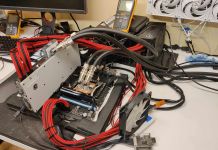Samsung’s development of GDDR5 memory has reached a new milestone as it has announced mass production of 50 nanometer circuits with a maximal data transfer rate of 7.0Gbps. The new memory chips can operate at 1750MHz, which results in an effective clock frequency of 7.0GHz, which can be compared to the 4.0GHz GDDR5 chips that most Radeon HD 4800 graphics cards use. It has also managed to lower the voltage to 1.35V which in turn reduces power consumption. With a 512-bits memory bus these chips could be used to hit a fabulous bandwidth of 448GB/s. The chips will appear later this year.
More in Samsung’s press release;
SAMSUNG Begins Mass Production of High-performance GDDR5 Memory Using 50-nm Class Process Technology
Seoul, Korea – February 12, 2009 : Samsung Electronics Co., Ltd., the world leader in advanced memory technology and the leading producer of high-end graphics memory, announced today that it has begun mass producing GDDR5 graphics memory using 50-nanometer class process technology.
”Our early 2009 introduction of GDDR5 chips will help us to meet the growing demand for higher performance graphics memory in PCs, graphic cards and game consoles,” said Mueez Deen, director, mobile and graphics memory, Samsung Semiconductor, Inc. ”Because GDDR5 is the fastest and highest performing memory in the world, we’re able to improve the gaming experience with it across all platforms,” he added
Designed to support a maximum data transfer speed of 7.0Gbps, Samsung’s GDDR5 will render more life-like (3D) imaging with a maximum 28GB/s bandwidth, which is more than twice that of the previous fastest graphics memory bandwidth of 12.8GB/s for GDDR4. The ultra-fast processing speed is equivalent to transferring nineteen 1.5GB DVD resolution movies in one second. The high image processing speed of the GDDR5 also supports the latest data formats (Blu-ray and full HD).
Unlike GDDR4, which processes data and images using the strobe-and-clock technique, the processing speed of the GDDR5 is much faster because it operates with a free-running clock that does not require the data read/write function to be synchronized to the operations of the clock.
By adopting 50nm class technology, Samsung expects production efficiency to rise 100 percent over 60nm class technology. In addition, Samsung’s GDDR5 operates at 1.35 volts (V), which represents a 20 percent reduction in power consumption compared to the 1.8V at which GDDR4 devices operate.
Now available in a 32Megabit (Mb) x32 configuration and also configurable as a 64Mb x16 device, Samsung expects GDDR5 to account for over 20 percent of the total graphic memory market in 2009. The company also said it plans to expand the 50-nm process technology throughout its graphics memory line-up this year.




















Leave a Reply